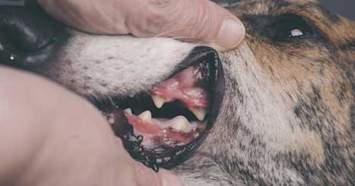
What is periodontal disease?
Periodontal disease is a condition in which inflammation and infection from bacteria and dental tartar break down the tooth’s support structures, such as the gums (“gingiva”), ligaments attaching the tooth to the jaw bone, and the surrounding bone itself. Some periodontal disease is reversible, but only with proper and prompt treatment, such as a “dental.” According to Brooke Niemiec, a veterinary dentist who spoke at the 2016 World Small Animal Veterinary Association meeting, “Periodontal disease is the number one health problem in small animal patients. By two years of age, 70% of cats and 80% of dogs have some form of periodontal disease.” Over time, periodontal disease can lead to loose, diseased teeth, infection, oral ulcers (open sores in the mouth), and even heart or kidney disease.
What is a dental?
“Dental,” “dental procedure,” “dental prophy,” “dental cleaning,” or “dental prophylaxis” are all terms that essentially mean the same thing: cleaning and polishing your pet’s teeth while under anesthesia to prevent and treat periodontal disease. Anesthesia is necessary because veterinarians will need to check and clean beneath the gums in order to prevent and treat periodontal disease. The visible tooth is usually just the ‘tip of the iceberg’ and more severe tartar, infection, and ligament or bone disease can be present below the gum line. Your veterinarian may also want to take dental radiographs or x-rays to ensure no underlying fractures, bone loss, or tooth re-absorption (“resorption”) is present or occurring.
Sometimes, a tooth has become so diseased that it is infected and no longer attached to the bone. Veterinarians will actually remove or “extract” such teeth in order to let the mouth heal and prevent infection from going into the blood stream. In general, adult dogs have 42 teeth and adult cats have 30 teeth, so extracting the occasional diseased tooth will not prevent a pet from being able to eat normally once they have healed. In fact, the mouth of a dog or cat is so tough that most could continue to eat hard or crunchy food without any teeth at all! Your pet may actually eat better after a dental because diseased teeth are often quite painful, so removing them can be a huge relief for a pet.
Note: Wellness Rewards from Embrace Pet Insurance covers dental cleanings.
Does my pet need a dental?
Often, veterinarians will recommend routine dental cleanings every 6 to 12 months to prevent tartar from building up and ensure all teeth are healthy. For those pets that don’t make it in for their dentals regularly, here are some ways to tell if your pet might be in need of a dental:
Crusty or discolored material (tartar) on the teeth
Bleeding in the mouth
Red or puffy gums, especially near the tooth
Loose teeth
Bad breath
Chewing only on one side of the mouth
Drooling
Pickier appetite
If you notice any of these symptoms, have your veterinarian check your pet’s mouth and help you determine if a dental procedure is needed and what to expect from it. Depending on the diagnosis, the treatment may be covered with dental pet insurance coverage.
Dental After-care
Once your pet gets home from his or her dental, drowsiness and disorientation are common but should improve within 24 hours. Your pet may even be a little nauseous from the anesthesia. It is best to offer a smaller meal than usual to ensure your pet’s stomach won’t get upset. Be sure to wait until your pet is fully awake and aware before offering any food. Ask your veterinarian if your pet will need a specific diet while he or she recovers. If oral surgery was performed, such a suturing or sewing the gums together after a large tooth has been extracted, soft food is usually recommended for at least one week after the procedure. Any sutures or stitches in the mouth should dissolve over time. Monitor your pet for bleeding or drooling, and give any medications you received exactly as prescribed. Call your veterinarian if you have any questions or concerns.